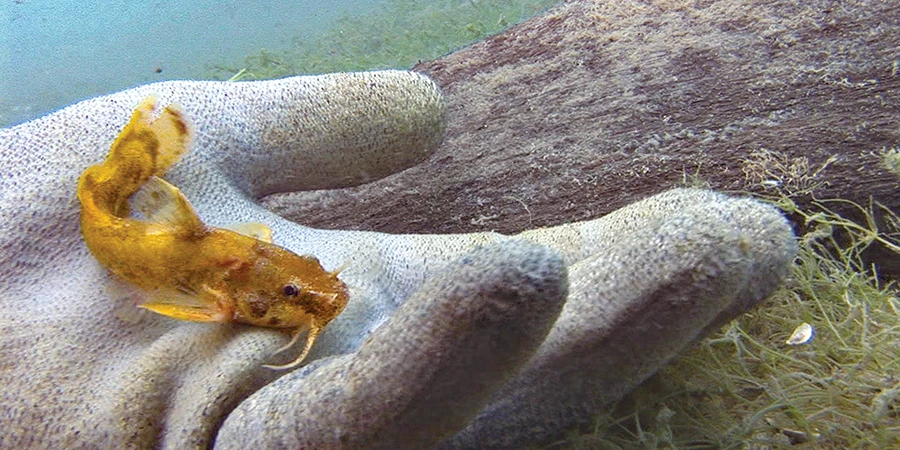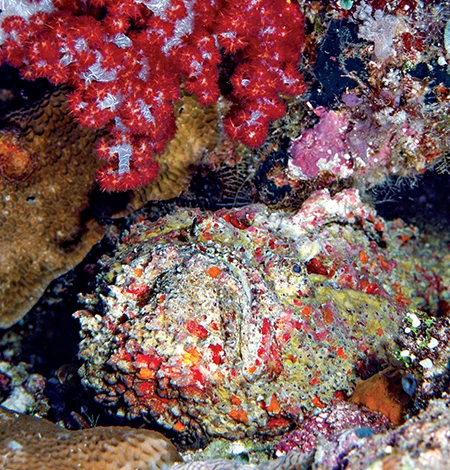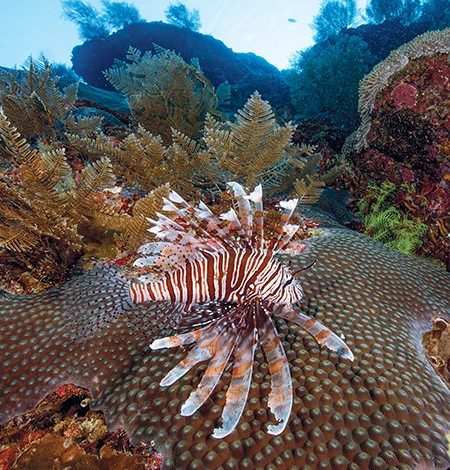Maintaining a respectful distance from potentially harmful species underwater is a tenet of good recreational diving and a frequent topic of charter boat predive briefs. But those venomous fish you have learned to avoid might save your life someday.
Researchers estimate that between 2,000 and 3,000 fish species produce some form of venom. Many of these species are common on tropical coral reefs in both the Atlantic and the Pacific. Lionfish, scorpionfish, and stonefish are well-known among divers as venomous, but any species with the ability to deliver toxins — whether through a bite, sting, or stab — are considered venomous, as opposed to poisonous fish that are only toxic when consumed. Fish venom contains toxins that adversely affect a victim’s physiology.
Fish use venom in two ways: to aid predation and to avoid being eaten themselves. A venom that impairs the circulatory system can slow down prey, while neurotoxins can completely immobilize a potential meal. Inflicting pain is an effective defensive tactic for stopping predators and might be the only way a small fish can avoid being eaten, which may explain why some small fish species produce extremely painful venom.
Nathan Lujan, PhD, associate curator of fishes at the Royal Ontario Museum in Toronto and assistant professor in the department of ecology and evolutionary biology at the University of Toronto, Canada, has spent hundreds of hours studying fish throughout the Caribbean, North America, South America, and the South Pacific. A 2-foot (0.6-meter) armored catfish stung him in South America, and a 6-inch (15-centimeter) madtom catfish did the same in North America. He recalled that the tiny madtom’s sting was much worse, with intense localized pain lasting several hours.
Lujan said most catfish venom is nonlethal to humans. Nevertheless, he strives to avoid being stung. While most scientists take extreme caution to avoid direct contact with fish venom, some researchers seek the world’s deadliest fish to help save human lives.

Rx: Fish Venom
A 2020 article in the International Journal of Pharmacy and Pharmaceutical Sciences reviewed more than 150 studies of medical applications for fish venoms. Authors Shweta Pandey and Ravi Kant Upadhyay found fish venoms contain many components — including enzymes, peptides, and proteins — that lend themselves to a wide range of medical applications, from wound care and tissue regeneration to multiple sclerosis and cancer treatments.
“It’s common in medicine to use things that would be considered toxic in small doses and in appropriately controlled settings to take advantage of the toxicity for a health benefit,” said Julie Gronek, MD, FABPMR.
Fish venom works by disrupting or altering how bodily systems function. Researchers are replicating the venom formulas to create synthetic antipathogens, antibacterials, analgesics, antimicrobials, antibiotics, and more.
“People are relatively familiar with chemotherapeutic agents, which are really just out-and-out poison,” Gronek said, “but they kill faster-growing cells rather than slower-growing cells, so they can be used to kill tumors. That’s a classic example, but we do it with all types of drugs.”
Researchers are studying pardaxin, found in the venom of Red Sea flatfish, as a potential cancer treatment. According to Pandey and Upadhyay’s review, pardaxin has been shown to selectively trigger the death of cancer cells, may prohibit cancer cells from spreading, and does not appear to negatively affect human cells.
Studying pharmacological uses for fish venom is ongoing but not without challenges. Fish venom is difficult to collect and is unstable at normal ambient temperatures. Thankfully for the fish, sampling venom is not a lethal process.


Treating Stings
Fish venom injuries are costly to public health, leisure, and tourism. Human reactions to fish venom stings can range from mild irritation to death. Pandey and Upadhyay found that venomous fish contribute to thousands of fatalities yearly, particularly among divers, tourists, and fishers.
Victims of highly toxic fish venom can rapidly develop symptoms ranging from pain and localized swelling to headache, abdominal pain, vomiting, hypertension, hypotension, shock, convulsions, and cardiac arrest.
Fish antivenom is available, and some venom structures are similar enough that the antivenom for one species may effectively treat stings from other species. Antivenom therapy works by neutralizing fish venom toxins, which can provide lifesaving protection to victims of lethal stings.
Unfortunately, Pandey and Upadhyay found that lifesaving fish antivenom is scarce due to the high cost of production and limited storage life. This scarcity particularly affects rural populations in remote regions.
All stings should be treated properly, as even nonlethal stings can turn deadly. In the same way that a bee sting can be fatal for some people, an allergic reaction to a fish sting can turn a painful but survivable situation into a deadly scenario.
Treatment for nonlethal fish stings typically focuses on pain relief and involves soaking the affected area in warm water. Proper treatment is important because fish stings can also impose the risk of secondary bacterial infections and other complications that may require further medical intervention. More information on hazardous marine life stings is available at dan.org/health-medicine/health-resources/diseases-conditions/ive-been-stung-what-should-i-do/.
While people should avoid close encounters with venomous species, thousands of fish species rely on their venom to help them catch their food and avoid becoming a meal for another creature. Someday, a fish venom formula might help to slow your racing heart or destroy the tumor threatening your life.
© Alert Diver – Q4 2024